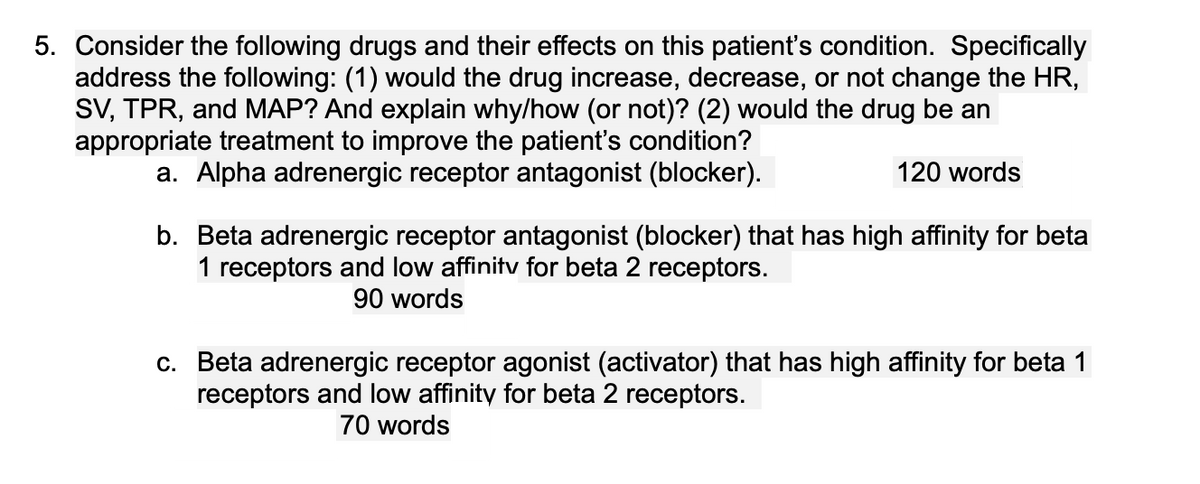5. Consider the following drugs and their effects on this patient's condition. Specifically address the following: (1) would the drug increase, decrease, or not change the HR, SV, TPR, and MAP? And explain why/how (or not)? (2) would the drug be an appropriate treatment to improve the patient's condition? a. Alpha adrenergic receptor antagonist (blocker). 120 words b. Beta adrenergic receptor antagonist (blocker) that has high affinity for beta 1 receptors and low affinity for beta 2 receptors. 90 words c. Beta adrenergic receptor agonist (activator) that has high affinity for beta 1 receptors and low affinity for beta 2 receptors. 70 words
5. Consider the following drugs and their effects on this patient's condition. Specifically address the following: (1) would the drug increase, decrease, or not change the HR, SV, TPR, and MAP? And explain why/how (or not)? (2) would the drug be an appropriate treatment to improve the patient's condition? a. Alpha adrenergic receptor antagonist (blocker). 120 words b. Beta adrenergic receptor antagonist (blocker) that has high affinity for beta 1 receptors and low affinity for beta 2 receptors. 90 words c. Beta adrenergic receptor agonist (activator) that has high affinity for beta 1 receptors and low affinity for beta 2 receptors. 70 words
Chapter21: Medications Used For Musculoskeletal System Disorders
Section: Chapter Questions
Problem 25RQ
Related questions
Question
Please answer questions 5 parts a, b, and c

Transcribed Image Text:5. Consider the following drugs and their effects on this patient's condition. Specifically
address the following: (1) would the drug increase, decrease, or not change the HR,
SV, TPR, and MAP? And explain why/how (or not)? (2) would the drug be an
appropriate treatment to improve the patient's condition?
a. Alpha adrenergic receptor antagonist (blocker).
120 words
b. Beta adrenergic receptor antagonist (blocker) that has high affinity for beta
1 receptors and low affinity for beta 2 receptors.
90 words
c. Beta adrenergic receptor agonist (activator) that has high affinity for beta 1
receptors and low affinity for beta 2 receptors.
70 words

Transcribed Image Text:Question
A patient has a rare disorder in which tumors of the adrenal medulla are over-secreting
catecholamines (epinephrine and norepinephrine) into the blood. "Normal" refers to the
person without these tumors.
Answer the following questions for this patient.
1. What is the patient's resting HR compared to “normal"? Explain your answer at the
level discussed in lecture. Be sure to include the location and type(s) of receptors,
cell type(s), and any channels that are involved in the change.
100 words max
2. What is the patient's resting SV compared to “normal"? Explain your answer at the
level discussed in lecture. Be sure to include the location and type(s) of receptors,
cell type(s), and major proteins and processes that are involved in the change.
185 words max
3. What is the patient's resting TPR compared to "normal"? Explain your answer at the
level discussed in lecture. Be sure to include the location and type(s) of receptors,
cell type(s), and processes that are involved in the change.
110 words max
4. What is the patient's MAP compared to "normal"? Briefly explain your answer
50 words
max
Expert Solution
Step 1
Please Note:Dear user,You have posted more than 1 question .In fact we have liberally answered 2 questions.So,for more answers to be resolved ,kindly repost the question.
Pharmacological Intervention plays a critical role in lowering blood pressure among patients with hypertensive crisis especially those affected by adrenal tumors.Extra caution needs to be taken to lower down blood pressure prior to patient undergoing surgery not the same to avoid intraoperative and postoperative complications.
Step by step
Solved in 2 steps

Recommended textbooks for you









Essentials of Pharmacology for Health Professions
Nursing
ISBN:
9781305441620
Author:
WOODROW
Publisher:
Cengage